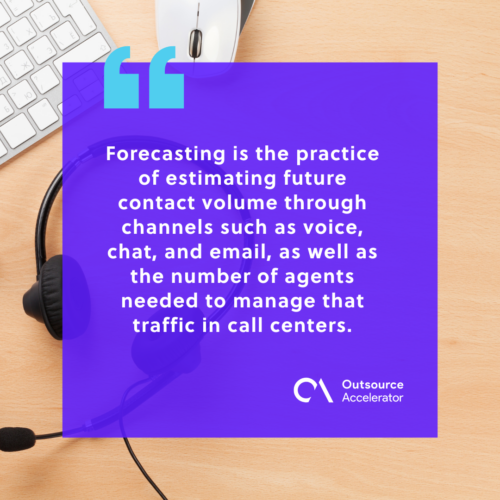Call center forecasting
Definition
What is call center forecasting?
Forecasting is the practice of estimating future contact volume through channels such as voice, chat, and email, as well as the number of agents needed to manage that traffic in call centers.
Historical volume data, which generally includes information on seasonal trends and year-over-year increases or declines, is widely used in forecasting.
Future business events, such as the launching of important new goods or the distribution of new software upgrades, should be included in forecasting. Historical data can also be used to aid in the modeling of these events.
Forecasting isn’t a project that can be completed once and then set aside. It’s a continuous process that requires frequent adjustments.
Workforce managers, who are typically in charge of forecasting, may produce a long-term forecast to determine how many agents are required for recruiting plans. They will regularly update shorter-term forecasts to support agent scheduling choices.
This brings up a crucial point where effective scheduling requires accurate forecasting.
Schedules are created based on forecasted volumes, which means forecasting has an impact on labor expenses as well as customer satisfaction.
It comes with a direct impact on key performance indicators (KPIs) such as average wait time and average response time.
It’s a great way that workforce management software exists since forecasting is so important to the customer experience and the financial line.
Workforce management software makes the forecasting process easier and more precise.
Top-tier systems can account for various channels and multi-skilled agents, making the difficult task of omnichannel forecasting much easier.
Forecasting call volumes and human resources do not have a one-size-fits-all solution.
With the right approach, you’ll be able to produce much more accurate projections, allowing businesses to optimize productivity while avoiding understaffing as much as possible.

How to forecast call volumes?
The main goal is to assess how many full-time equivalent (FTE) agents your contact center will require on a daily basis so that you can plan existing employees accordingly.
Businesses need to estimate how many calls they will get or make on a daily and hourly basis to ensure this goal.
First, determine how long your prediction will last. Predicting staffing needs for the coming year is useful for long-term resource planning, but it may not be as useful for weekly hiring and training.
As call volumes may arise unexpectedly or employees may call in sick, you’ll need to plan your staffing needs frequently. This is why many call centers prioritize weekly and monthly forecasts over year projections.
Therefore, they are more likely to make call center staffing choices every week or every day, rather than every year, so having this greater degree of detail is important.
It’s important to note that if you want to create more detailed forecasts, call centers need to do it more frequently.
Forecasting with accuracy – a key challenge for call centers
Call centers are referred to as people businesses. The interactions between consumers and agents are at the core of coordination and management.
Customers’ demand for the services provided by a call center might change. To accommodate such changes, companies must guarantee that their supply of consultants is flexible.
Workforce management (WFM) is the process of scheduling and recruiting agents to satisfy demand.
The only way to accomplish effective workforce management is to forecast contact volume accurately.
Forecasting is done at call centers using a variety of methods. These methods produce complicated predictions using a variety of data.
Call centers put an emphasis on efficiency, quality, and other key performance indicators. They use this method to keep on track and manage their forecasts effectively.







 Independent
Independent




